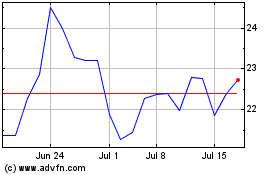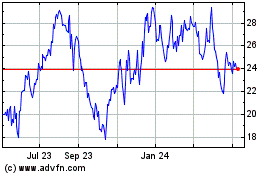Rising costs, including the surging price of cotton, are forcing
apparel retailers to get creative in how to limit the higher
expenses' impact on their profits and what they charge
customers.
Retailers like J.C. Penney Co. (JCP) and Macy's Inc. (M) are
trying to cut costs by negotiating with suppliers and seeking
cheaper areas for production. The goal is to find internal ways of
absorbing rising commodity expenses and to avoid raising prices too
much for the still-fragile U.S. consumer.
Strategies at play for retailers include increasing price on
items that are already more expensive. This would allow retailers
to hold the line on lower-priced goods, so the price increases
wouldn't be as obvious to shoppers.
The overall challenge, though, is difficult, J.C. Penney Chief
Executive Myron "Mike" Ullman told Dow Jones Newswires, because
there is a "stress in the system" that hasn't been seen in close to
20 years.
"The fact is, apparel prices are going up," Ullman said. Most
retailers were able to book orders as they saw cotton prices
beginning to rise last year, which is keeping apparel prices pretty
static early this year, but increases are seen as inevitable
starting around mid-year.
With the price of cotton, a chief component of clothing
including high-end dresses and every-day jeans, having more than
doubled over the past year, along with higher labor prices for
manufacturing and increased transportation costs, 2011 will be a
year for retailers to try to buffer themselves from inevitably
higher costs.
At Macy's Inc. (M), Chief Executive Terry J. Lundgren said some
retailers "will take the quality down so they have the price they
can hit, others will negotiate" with suppliers. "It's all being
worked on."
It may also be difficult to look for other blends, because "all
of the fibers are going to face inflationary challenges," Lundgren
told Dow Jones Newswires.
Despite retailers' efforts to avoid passing all the costs to
consumers, many still see price tags rising by mid-single-digit
percentages and even more, depending on the product, and the timing
couldn't be worse. The economy is still sluggish, and even though
U.S. consumers turned out for the holidays, their enthusiasm waned
as the season progressed.
Now, faced with higher prices after decades of lower costs for
apparel, there could be a return to consumer timidity. Any
reluctance would be difficult to deal with, since the recession and
continued soft economy has forced retailers to wring out just about
all excess costs, leaving them with little wiggle room to absorb
another sales decline. Inventory management has taken on even more
importance, with retailers not wanting to be left with unsold,
higher-costing goods.
J.C. Penney, like other large retailers, is using its worldwide
merchandise procurement, or sourcing, system to look at locations
other than the outer fringes of China, the world's main apparel
producer, to try to mitigate costs. As China's economy has grown,
so has the wealth of many of its residents, and they are now
consumers instead of low-wage apparel producers.
Some retailers are moving their production to other spots, like
further into China, where it is more rural, as well as establishing
a presence or stepping up operations in countries like India and
Vietnam, where costs are cheaper. The danger, though, is that some
areas are not as adept as China had become, and quality and
logistical problems could develop.
J.C. Penney feels it is among the better-positioned retailers
because it has had its own overseas sourcing operation for decades
and has a good handle on what is coming down the pike.
Ullman said J.C. Penney will still hold its popular promotional
sales, but not for as long. He added the company has the advantage
of being lower-priced than its nearest competitor, and flexibility
as a result. The company can also "re-engineer product without
compromising quality."
Between materials, labor and freight, retailers are looking at a
10% to 15% increase in apparel costs in the second half of this
year, said Richard Jaffe, retailer analyst at Stifel Nicolaus.
Retailers that will do best as prices rise will have "unique,
highly differentiated product, because consumers are much less
price-resistant when the product is compelling," Jaffe said. "It's
going to be the retailer's challenge to inspire consumers and
motivate them" because they will not be able to rely on cheap
prices.
Jaffe feels Kohl's Corp. (KSS), Urban Outfitters Inc. (URBN),
Gap Inc. (GPS), Men's Wearhouse Inc. (MW) and TJX Cos. (TJX) each
have certain attributes, like unique products, exclusive brands and
a general cache to do well in the escalating cost environment.
-By Karen Talley, Dow Jones Newswires; 212-416-2196;
karen.talley@dowjones.com
Kohls (NYSE:KSS)
Historical Stock Chart
From Jun 2024 to Jul 2024

Kohls (NYSE:KSS)
Historical Stock Chart
From Jul 2023 to Jul 2024
